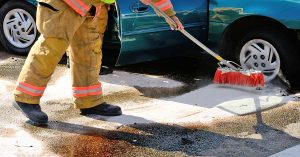Identifying and correcting regulatory noncompliances can prevent harmful releases to the environment and reduce potential violations. They can also be used as tool to minimize risk and identify environmental management priorities. Having an experienced firm on your side to assist with the auditing process is incredibly valuable and can help your organization ensure compliance and avoid costly fines.
What Is an Environmental Compliance Audit?
An environmental compliance audit is a tool used by facility managers to evaluate a facility’s compliance with federal, state, and local environmental regulations. Environmental compliance audits provide organizational leaders and facility managers with necessary information regarding their environmental program’s performance, challenges, and risks.
An environmental compliance audit will typically evaluate, as applicable, the following:
- Waste streams
- Business operations
- Discharges
- Hazardous and chemical material handling and usage
- Permitting required compliance
- Recordkeeping
- Reporting
The audit is comprised of pre-audit, onsite, and post-audit activities. The pre-audit activities are just as important as the onsite inspection; however, they are often overlooked and undervalued by potential clients. The audit team typically submits a pre-site visit questionnaire that the audited facility completes in advance of the onsite inspection. The PSVQ paints a picture of the environmental activities at the facility that allows the audit team to better prepare for the onsite inspection. Additionally, the audit team will request all environmental records, plans, and permits so they can evaluate them in advance and be well-prepared to ask questions while onsite and be very thorough during the inspection process.
The onsite audit generally involves an inbrief, where the audit team kicks off the audit with facility personnel to explain the audit process and review the agenda for the term of the audit. The audit team will inspect the facility, interview key personnel, and review any remaining records that are only available onsite. The success of the audit depends on the availability of key personnel during the onsite inspection.
The environmental compliance audit will result in a report that an organization or facility can use to inform its decision making to determine what program areas need improvement. The report typically identifies regulatory compliance status across the scoped regulations, often referred to as “findings” or “noncompliances”. These findings are often assigned a priority rank based on type of noncompliance (i.e., regulatory noncompliance vs. policy noncompliance). In some cases, facilities will also request that auditors note findings that are considered “best management practices”, which are issues that are not yet a noncompliance but eventually could become one. The audit report most often includes corrective actions that can be implemented at the facility to resolve the findings.
The Importance of Working With an Experienced Firm
Hiring an experienced environmental consulting firm provides the audited organization access to decades of experience and knowledge. The firm has already established an audit process and has resources available to ensure the audit’s success. One of the most important aspects of the audit is identifying corrective actions that provide long term solutions, rather than quick fixes. An experience environmental consulting firm will have auditors on staff who have conducted many audits in all types of facilities. These auditors complete a root-cause analysis on each finding and can identify why the noncompliance occurs, or re-occurs, and can assist the facility with identifying the long term corrective actions.
Finally, a consulting firm can provide compliance assistance, risk evaluation, planning, and support for obtaining the company’s sustainability goals.
When seeking an environmental and safety consulting firm, search no further than Aarcher Consulting. For more than 25 years, we have provided our clients with expert assistance in mitigating their environmental and safety risks while meeting their goals.
Aarcher Consulting only employs the top industry talent, ensuring that every client receives a customized, comprehensive assessment. We have proudly served 5,000+ facilities and companies in virtually every industry, including more than 25 state and federal government agencies and several Fortune 500 companies. Aarcher Consulting’s commitment to excellence sets us apart from the rest, and we provide expert consulting services for commercial, government, and industrial clients nationwide.
Wherever your company is located, Aarcher Consulting will be there to provide trustworthy environmental and safety consulting that ensures the safety of your employees and the environment.
Resources:
Environmental Compliance Audits and Facilities Management, FMLINK, fmlink.com.
How are Environmental Compliance Audits Conducted?, SafetyStratus Research Advisory Group, SafetyStratus.com.

 Oil-handling personnel must initially be trained when hired or assigned, when the facility changes, and when the SPCC Plan is amended. Every year thereafter, conduct annual SPCC briefings for these employees.
Oil-handling personnel must initially be trained when hired or assigned, when the facility changes, and when the SPCC Plan is amended. Every year thereafter, conduct annual SPCC briefings for these employees. Sarah Campbell is an environmental compliance specialist supporting environmental programs for land management agencies, Federal facilities, and private commercial companies. She has her hands in many projects, including NEPA planning, Environmental Management Systems, stormwater protection, and landowner liability research. Sarah can be reached at
Sarah Campbell is an environmental compliance specialist supporting environmental programs for land management agencies, Federal facilities, and private commercial companies. She has her hands in many projects, including NEPA planning, Environmental Management Systems, stormwater protection, and landowner liability research. Sarah can be reached at  As opposed to a commercial ESA where the property footprint consists of a building, series of buildings, a city block, or an undeveloped acreage, a wireless Phase I ESA is typically focused on a specific site location, existing tower compound, or proposed installation path within a building. The wireless company is concerned not only with the general environmental condition of the underlying property, but specifically with the areas that will be impacted by their planned installation.
As opposed to a commercial ESA where the property footprint consists of a building, series of buildings, a city block, or an undeveloped acreage, a wireless Phase I ESA is typically focused on a specific site location, existing tower compound, or proposed installation path within a building. The wireless company is concerned not only with the general environmental condition of the underlying property, but specifically with the areas that will be impacted by their planned installation.